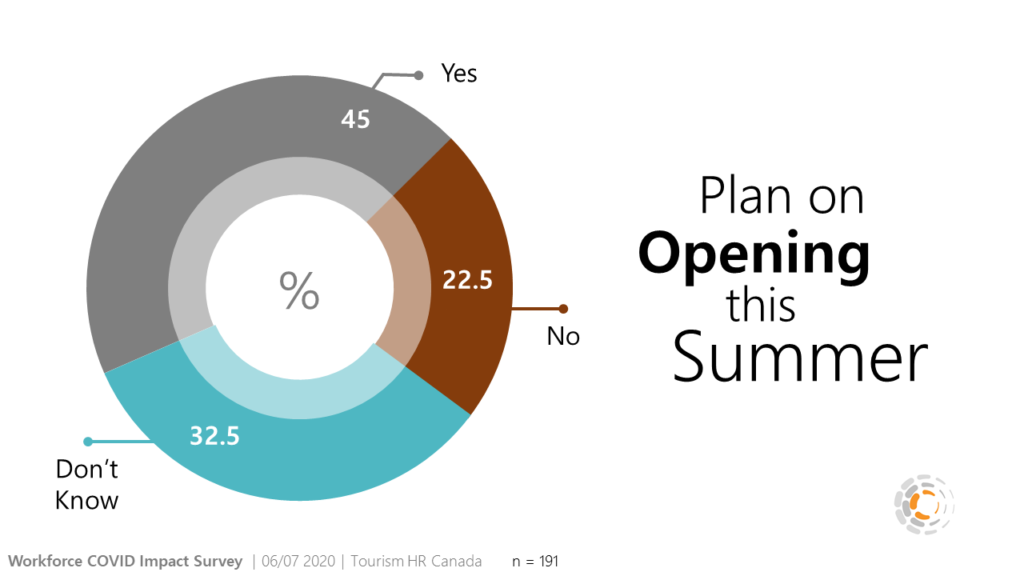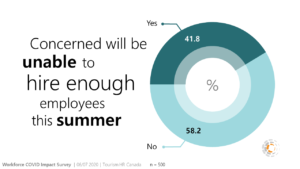Tourism businesses have gradually started to reopen and recall workers that have been furloughed for months. The process has been met with trepidation and confusion, and with some workers refusing to return to work, many for legitimate reasons.
The Struggle with Recalling Workers
Employers are seeking assistance on making decisions on whom they bring back, when, and how to avoid possible liabilities. Employers have also expressed uncertainty about bringing workers back, citing concerns about financial stability and whether they are able to offer steady, predictable employment without the possibility of laying workers off once again.
Questions on the duration or utility of the Canadian Emergency Wage Subsidy (CEWS) program and added uncertainty on the opening of borders or lifting of other restrictions limiting tourism have made it a difficult and risky proposition to decide whether to sustain operations, and hence whether it is feasible to rehire workers.
The bottom line: businesses are not yet profitable and struggle to operate on highly reduced revenues. In addition, the requirements to operate safely during this pandemic have added significantly to the costs of doing business while limiting the number of guests operators can feasibly serve.
Tourism HR Canada just completed a pan-Canadian Workforce Impact Survey for the tourism sector. Only 6% of businesses reported being fully open, while another 60% indicated they were open but with limitations or restrictions. Nearly 31% declared they were temporary closed. When asked if they were planning to open this summer, 22% of respondents indicated they would not be opening, and another 32% said they didn’t know.
Of the top workforce issues for tourism businesses, the Workforce Impact Survey revealed that 42% of employers were concerned about hiring enough workers for the summer season.
To understand this challenge, employers were asked about the barriers to finding sufficient workers. Among the 17 items, the most common factors were:
- Potential workers choosing Canadian Emergency Response Benefit (CERB) over returning to work (61.7%)
- The Canadian Emergency Wage Subsidy (CEWS) ends too early (37.4%) (note that the survey wrapped prior to the proposed December extension)
- Recruitment difficulties associated with the seasonal nature of the work (35%)
- Wage expectations of potential employees are too high (31.1%)
These factors highlight the fine balance businesses face with trying to bring workers back while operating with no profits and uncertain futures. Not surprisingly, it also contributes to reasons why employees may not be able to return to work or may refuse to be recalled.
The Challenge of Dealing with Employees Refusing to Return to Work
There are many reasons why employees may choose not to go back to work. Among them:
- Concerns that workplace/work context is ‘unsafe’. Tourism and hospitality jobs are often social by nature and involve a lot of ‘public-facing’ activities which often means that physical distancing is not possible.
- The employer is unable to guarantee stable employment. Workers have expressed concerns about inadequate hours or assurances of a regular paycheck, especially if earnings amount to less than the CERB benefit. Some are worried that if they start working, they will risk not having access to access CERB or other supports in the future, if needed.
- Workplaces have had to adapt to new circumstances, which also means there will be a change in workplace demands or skills (e.g., new protocols, different tasks being asked, requirements to wear protective equipment). Workers may be ill-prepared or uncomfortable taking on new tasks or job roles.
- Some employees are part of a high-risk group (e.g., over 65, underlying health conditions) and cannot risk the chance of getting COVID-19. They choose to remain isolated and will avoid work that requires interaction with others.
- Other employees may be living with someone who is high-risk and will not put these family members or friends at risk.
- Some employees may be required to care for a family member because of conditions brought on by the pandemic, such as a lack of childcare or eldercare or a spouse who is quarantined.
- Furloughed workers have expressed difficulty coping, which contributes to different mental health needs or other support requirements, and, subsequently, an inability to work.
- A common anxiety raised by employees concerns transportation: being averse to using public transportation but unable to pay for alternative means. Until there are safer options, it may not be feasible for them to return to work.
Business instability contributes to employment precarity. Learning to navigate the economic variables also means there is a need to work on the social factors; in other words, growing profits also means investing in people. This is a big challenge for business operators and for the sector overall.
For guidance and tools to help work through these challenges, check out our Tourism Workforce Recovery Toolkit at TourismRecovery.ca.



